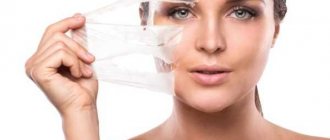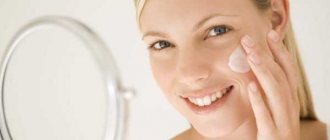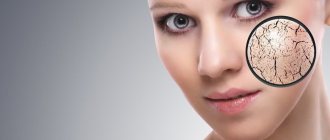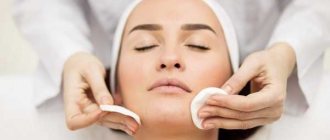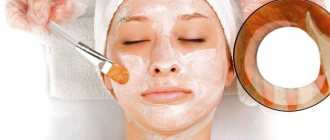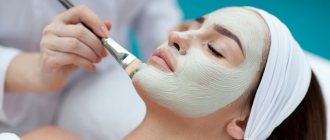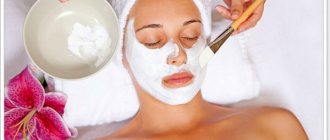The upper layer of the dermis becomes keratinized due to dying cells. They are being replaced by new ones. The formed layer is not removed naturally, which leads to the formation of a so-called shell on the face.
Using a facial scrub improves the appearance of the skin, making it more youthful, soft and seemingly glowing. Many people wonder how to choose a facial scrub. Everything is quite simple: we take into account skin type, financial capabilities and the final result.
Unlike regular soap or detergent, a facial scrub contains fine particles or abrasives that have a positive effect through the process of exfoliation. The most popular component is natural salt, which has a gentle effect.
Benefits of a facial scrub developed based on natural salt:
- remove old epidermal cells;
- make the skin smooth and elastic;
- reduce acne marks;
- saturate cells with oxygen;
- charge the skin with health;
- even out complexion.
Dead cells accumulated on the epidermis slow down the renewal process, preventing the penetration of nutrients and the regulation of sebum. In the absence of proper care, black spots and peeling appear.
However, improper or excessive use of this remedy does more harm than good.
Before choosing a facial scrub, you should study how this product works and become familiar with the main criteria.
Choosing a facial scrub that gives results is difficult. Seeking this out often causes damage to the skin and is costly. There are many options on the market. But skin isn't universal, so it's hard to rely entirely on what other people say. What works for some will not necessarily work for others.
What are scrubs made from?
Any scrub, purchased or made at home, consists of two basic elements - a base and exfoliating particles (abrasives). The base can be a cream or gel texture or various oils. Abrasive particles can be synthetic or natural.
Natural particles are usually harder and may develop sharp corners and uneven shapes when ground. However, these are natural substances that are safe for both the skin and the environment. They effectively cleanse and renew the epidermis, and in addition, they can be used in homemade scrubs.
The advantage of synthetic abrasive particles is that they are softer, rounder, smoother, and more gentle on the skin. But many brands are gradually abandoning them in favor of natural ones, so as not to harm the environment: after all, when washing off the scrub, such particles end up in wastewater.
Each component has its own important mission in scrubbing:
- The base,
rich in oils and active ingredients, helps soften the process and delicately cares for the skin. - Abrasives
perform the most important role - exfoliate dead skin particles. - Cosmetic clay
dries the skin and helps fight excess sebum production. - Antiseptics
kill harmful bacteria. - Acids and enzymes
enhance the effect of the scrub and help cleanse the skin deeper. - Menthol and essential oils
normalize the formation of sebum and have a tonic effect.
Question answer
To make it easier for abrasive particles to glide over the skin, it is recommended to include vegetable oils in your homemade facial scrub recipe. They give a softening effect.
The product is applied in an even layer, but the most problematic areas are massaged more actively, and on dry areas more gently. After 10-15 minutes, wash and apply moisturizer.
The use of homemade scrubs has a beneficial effect on the skin from several sides at once. Thanks to abrasive particles, everything unnecessary and harmful is pulled out of the pores, and natural ingredients productively saturate every cell. In turn, massage movements used to apply cleaning products enhance tissue microcirculation and increase turgor. We can conclude that such procedures are indispensable for getting yourself into proper shape.
Types of scrubs by type of effect
Depending on the composition and main active ingredients, scrubs are divided into two large groups.
1. Classic scrubs.
These products work by exposing solid particles to the skin: keratinized particles of the epidermis are removed due to friction. They usually contain tiny fragments of fruit seeds or nut shells, oatmeal or even shells. Food products can also be used: coffee particles, finely ground sugar or salt. When used correctly, such products are safe and cannot injure the skin.
The advantage of classic scrubs is that they can be used all year round. Another advantage of such products is that a classic scrub is easy to make yourself.
2. Peeling scrubs.
They are also called scrub peels. They not only scrub away dead skin particles, but also dissolve them with the help of acids and other chemical compounds of natural and artificial origin. The composition may include: alpha and beta hydroxy acids, citric, salicylic, glycolic, tartaric, lactic acids, as well as pumpkin, papaya, and pineapple enzymes. All of them dissolve dead skin cells well. The product is more effective, but it must be used very carefully. It is better to select acid scrubs and peels from a professional cosmetologist, carefully testing the composition to avoid burns and irritation. Acidic exfoliants should not be used in summer or on sunny days to avoid causing skin burns.
Aftercare
After applying the product, care for the epidermis is carried out using the following means:
- various masks, including herbal ones;
- nourishing and moisturizing serums;
- skin oils;
- creams.
After cleansing, the skin more readily absorbs beneficial substances and is saturated with them, so after scrubbing, professionals recommend using at least one of the above products.
Important! After the procedure, under no circumstances should you apply substances containing acid-containing products to your face, otherwise the development of inflammation and irritation is guaranteed.
Which facial scrub is suitable for sensitive skin?
Which facial scrub to choose is a task that can be solved in two ways: by consulting with a cosmetologist or by selecting a product by trial and error. Here are some basic tips on how to avoid these same mistakes.
Scrub for sensitive skin
should be as delicate as possible, without acids and enzymes, with soft small particles.
It’s good if the composition contains natural oils. thin skin
, while seeds and nut shells can damage it.
For those with oily and combination skin,
almost any product is suitable: you can choose gel bases and various options for abrasive particles.
To find out if a scrub is right for you, take a simple test right in the store. Try applying the product to the inner surface of your wrist and massage thoroughly: if the scrub is too harsh, it is better to discard it. And, of course, before use, always do an allergy test: apply the product to a small area of skin for 2 minutes, then rinse and observe the reaction for 24 hours. If it is not there, you can use a scrub on your face.
Precautionary measures
When choosing a product, you should pay special attention to the following points:
- It is better to give preference to gel-based substances.
- No individual intolerance to ingredients.
- The scrub must be suitable for your skin type.
- The abrasive particles from its composition must have a smooth shape.
- The base contains moisturizing and nutrients.
- Natural components have a positive effect on the recovery process.
If an allergic reaction occurs, it is recommended to consult a doctor.
When not to use a scrub
Scrubs and other exfoliants should not be applied to the skin if it has wounds or pimples. This can cause acne to worsen, spread infection and irritation, and cause discomfort during and after use. Scrubs should also be used with caution by people with thin, dry skin prone to damage, as well as with pronounced vascular network.
And remember: after active scrubbing, any skin becomes more susceptible to ultraviolet radiation and bacteria, so do not forget about protective cosmetics.
Expert opinion
- Cosmetologist
- Surgeon
Michelle Ellern
practicing cosmetologist-dermatologist
I would like to note that many speech therapists use the Face simulator. Before applying the prepared scrub, be sure to conduct an allergy test. To do this, apply a little product to the wrist or the inner bend of the elbow and wait a few minutes. If no redness or burning appears, then you can continue to act without fear of causing harm to health.
Theda Contis
How to use a facial scrub
In short: apply the scrub to the skin, massage, rinse. However, for maximum effectiveness of the product and its correct impact, several important points must be taken into account.
- It's always worth starting with a good cleansing. First, remove any remaining makeup using micellar water, milk, or another product. Then wash your face with foam, gel or special facial soap. Rinse off with warm water to prepare your skin for the next step.
- The second important step is steaming. A steamed face is easier to clean, and open pores will release excess oil and absorb beneficial substances from subsequent cosmetics. It would be ideal if you do this in a bathhouse or hammam, but at home it is enough to warm up properly in a hot shower or sit for a few minutes bending over a bowl of hot water. Be careful not to get burned by the boiling water! The procedure should be comfortable.
- After this, wash your face again with warm water, but do not wipe your face. The scrub should be applied only to damp skin so that the abrasive particles slide over it without injuring it. Massage your face with gentle movements. Move along the massage lines: from the corners of the lips to the temples, from the chin to the ears, from the center of the forehead again to the temples. For normal skin, a minute is enough; for oily skin, it is better to massage for 2-3 minutes.
- Rinse the scrub well with warm water. Dry your face with a soft towel. After the procedure, apply a moisturizer or mask; their effectiveness on scrubbed skin will be several times higher.
Important!
After the scrubbing procedure, products containing acid should not be applied to the skin. This may cause irritation and burns. Choose soft, delicate care products.
We will also answer popular questions about using scrubs.
When is the best time to use a scrub?
Deep cleansing of the skin with a scrub is best done before bed. Firstly, overnight the skin will calmly recover after the procedure, and minor redness after an active massage will disappear. Secondly, after scrubbing, the skin becomes thinner and more susceptible to the negative effects of ultraviolet radiation. Despite the fact that scrubs without chemical acids can be used at any time of the year, it is still better not to go outside immediately after the procedure. Or use sun protection, regardless of the time of year.
Scrubbing problem-free skin (5 recipes)
Even if there are seemingly no problems with your appearance, you cannot neglect the basic rules of skin care. Even healthy skin needs regular cleansing, as negative external factors leave their mark in the form of blackheads.
To get rid of them, it is recommended to carry out deep cleaning at least once a week.
Particularly noted recipes, according to women's reviews:
- Grind the avocado pulp using a blender and add 30 ml of brewed green tea and the same amount of almond oil. Then add 60-70 g of dark sugar. The product perfectly removes dirt from the surface and from the pores, additionally nourishes the skin with vitamins and other important elements.
- Knead 2-3 tbsp. spoons of raspberries or Victoria berries, add a few drops of mint or ylang-ylang ether. Used according to the standard scheme. The product is an excellent tonic.
- Several varieties of berries are combined: raspberries, currants, cranberries, strawberries and mashed with a fork. Then add heavy cream (5-7 ml), some finely chopped walnuts and wheat flour. Stir until a homogeneous consistency is obtained. An ideal substance for young skin with a refreshing effect.
- The following ingredients will be required: oatmeal (ground) - 40 g, almond oil - 7 ml, cranberries and black currants - 35 g, orange oil - 5 drops. After kneading, leave for 10 minutes to swell. The product is light but cleanses well.
- Combine natural yogurt (55 g), grapefruit or lemon juice - 10 ml and oatmeal - 4 g. Gently rub the resulting mass on the dermis for 4 minutes and rinse with cool water. As a result, the skin gains radiance and freshness.
Can I exfoliate with a body wash?
Experts do not recommend using body product to scrub your face. They explain this by saying that abrasive substances in body products are larger in size and can cause harm when applied to the face. Therefore, you need to use the product for its intended purpose, if the instructions say that it is for the body, then it is for the body and not for any other places.
Timely and proper care of the epidermis allows you to keep it beautiful and healthy for a long time. In this case, the products must fully correspond to the type of skin, otherwise the result may not please you and you will have to seek help from a specialist.
